Unit 5 of RAPS now world's 2nd longest running nuclear reactor
Rawatbhata (Rajasthan): India's nuclear power programme yesterday reached a new milestone after Unit 5 of the Rajasthan Atomic Power Station became the second longest running reactor in the world by being in operation for 765

Rawatbhata (Rajasthan): India's nuclear power programme yesterday reached a new milestone after Unit 5 of the Rajasthan Atomic Power Station became the second longest running reactor in the world by being in operation for 765 days continuously.
The Unit 5 of the Rajasthan Atomic Power Station (RAPS), a 220 MW Pressurised Heavy Water Reactor (PHWR), in Rawatbhata has been in uninterrupted operation since August 2, 2012 and it has been operating at full power with a capacity factor of 105 per cent.
It has since then generated around 4,258 million units of electricity.
The plant, commissioned in February 2010, has been running at the capacity of 98.5 per cent and until now generated 8,663 million units of electricity.
Speaking on the occasion, Department of Atomic Energy (DAE) Secretary Ratan Kumar Sinha, said the development was bigger than the Kudankulam Nuclear Power Station (KKNPP) unit 1 reaching its criticality as the success was a outcome of India's indigenously developed PHWR technology and it has sent an important message of "India's superiority".
"This is not only an emotional moment, but a moment of pride. There are only 10 reactors in the world that have crossed 500 days of uninterrupted operation. We can now tell the world that we are second in the world... And now numbers speak about this," Sinha said.
The DAE Secretary said in 1970 they would often make 3-4 trips in a month to RAPS because of the grid failure.
"People would then ridicule whether the power station actually works? At that time units 1 and 2 of RAPS were very new. India then developed the technology and mastered it," he said.
The Unit 5 of RAPS would be shut for maintenance, a mandatory procedure which is to be followed.
Unit 7 of Canada's Pickering nuclear plant holds the world record of running the largest operating plant that ran continuously for 894 days.
"We could have kept on generating electricity to create a world record. But, we have stopped the reactor purposely as we do not want cheap publicity. For us, safety is the first priority and we do not compromise on it," Sinha said.
The plant is expected to start its operations in a month after undergoing maintenance.
Sinha added in the year when DAE was celebrating its diamond jubilee the department had recorded many laurels.
"The Nuclear Fuel Complex produced around 1,000 tonne of fuel for the PHWR, the Uranium Corporation of India explored around 2 lakh tonne of uranium," said the Secretary DAE.
K C Purohit, Chairman and Managing Director of the Nuclear Power Corporation of India (NPCIL), recalled his days when he was working at the Rawatbhata site and dedicated today's achievement to the hard work of Indian scientists.
"When I joined in 1974, one unit was commissioned and second unit was far from being commissioned. At that time when our fellow Canadians (who were cooperating in the project) left us (after India first tested its atom bomb in 1974).
"We had little knowledge about this technology and even industrial support then. But then, we mastered this technology and we did not compromised on safety and security. We came to know some many things about the technology that we did not know before," Purohit said.
Sinha also added that the unit 1 of RAPS, which has been non-operational since 2004, will continue to remain non-functional.
"We thought the reactor could be used for producing isotopes for medical purpose, but then we have other techniques do so. It will remain non-operational, but as of now no decision has been taken to decommission the unit," he said.
RAPS has 6 units of which five are in operation. Work on units 7 and 8 are expected to be in operation by 2017-2018.